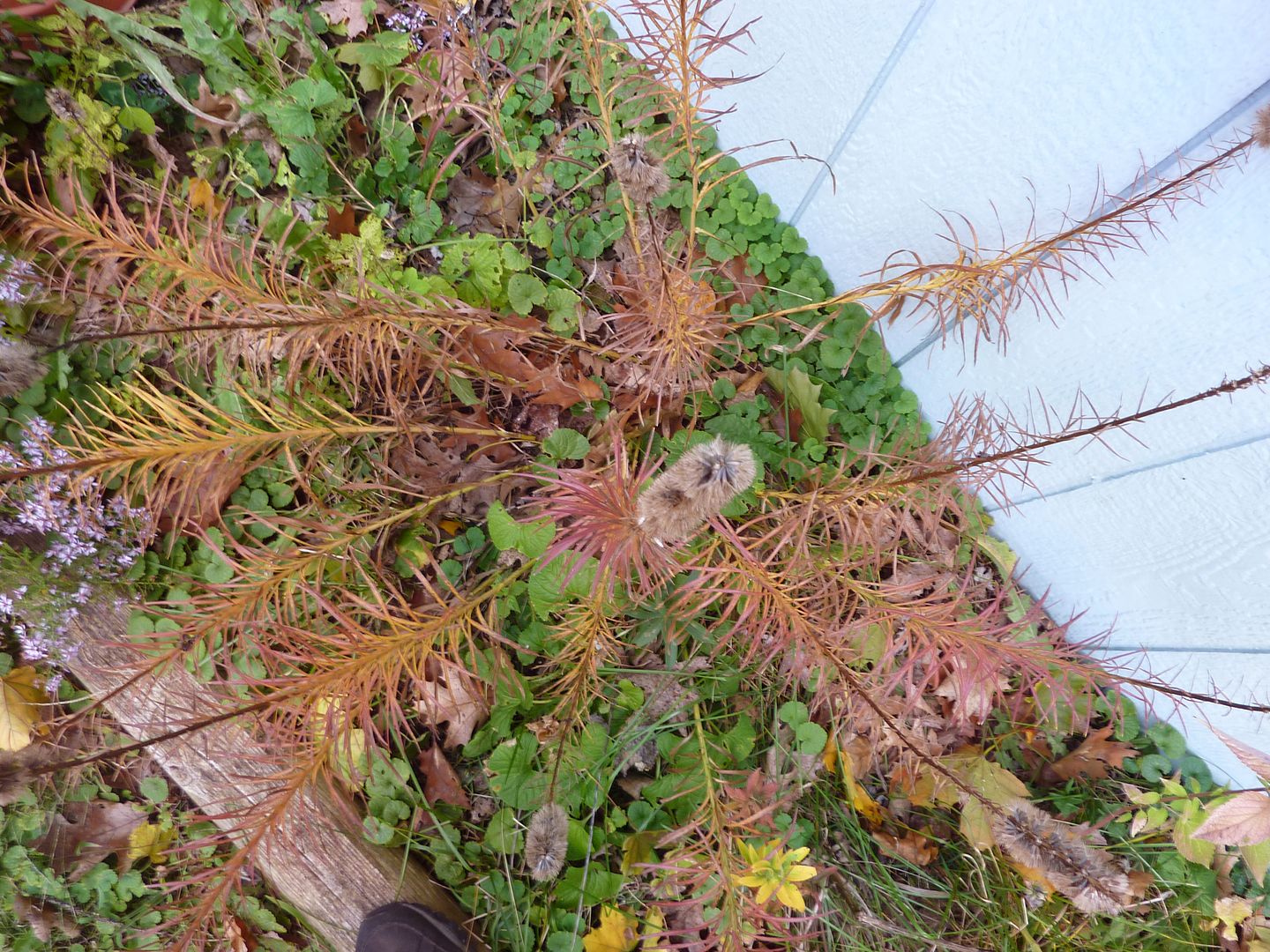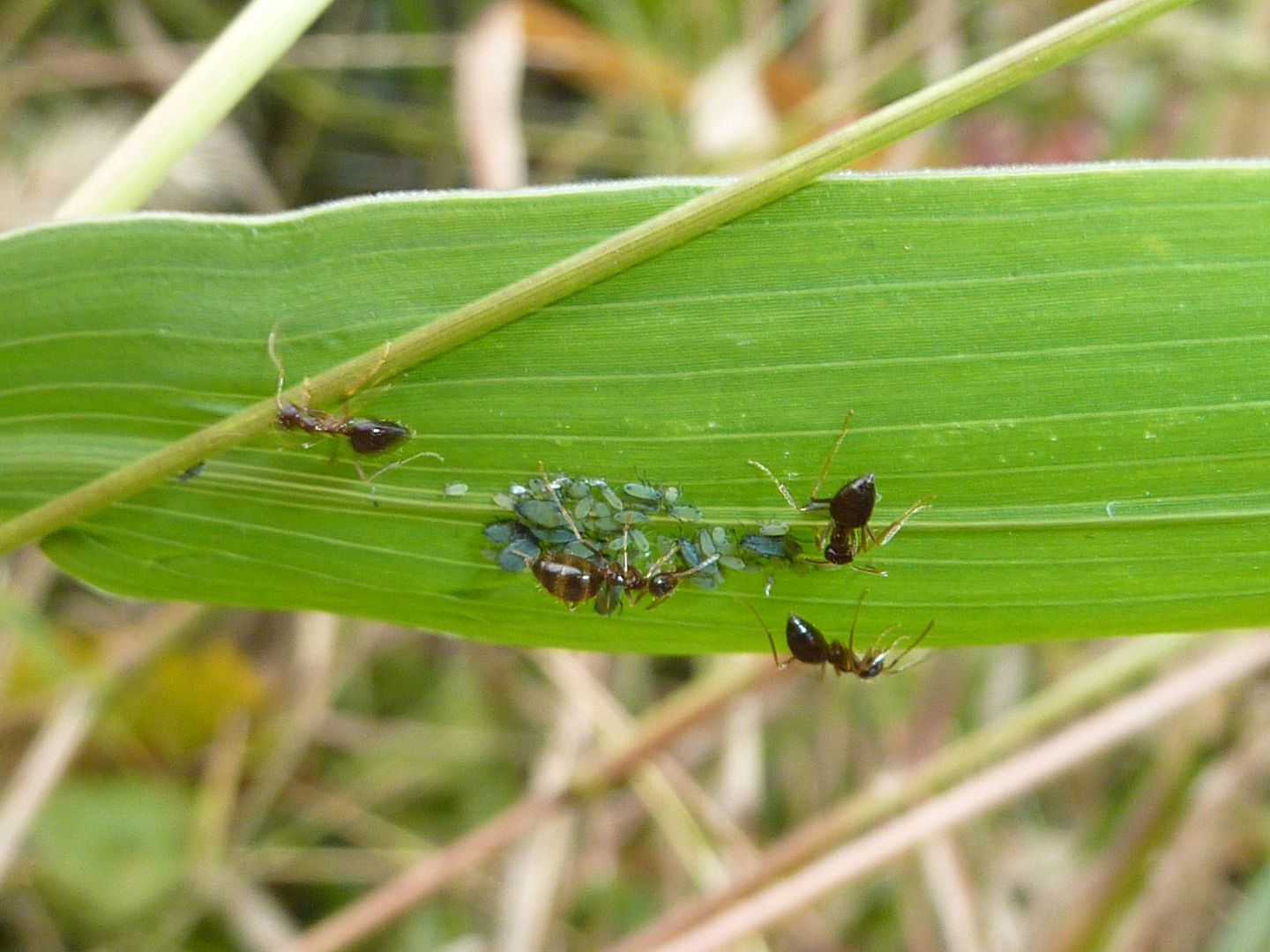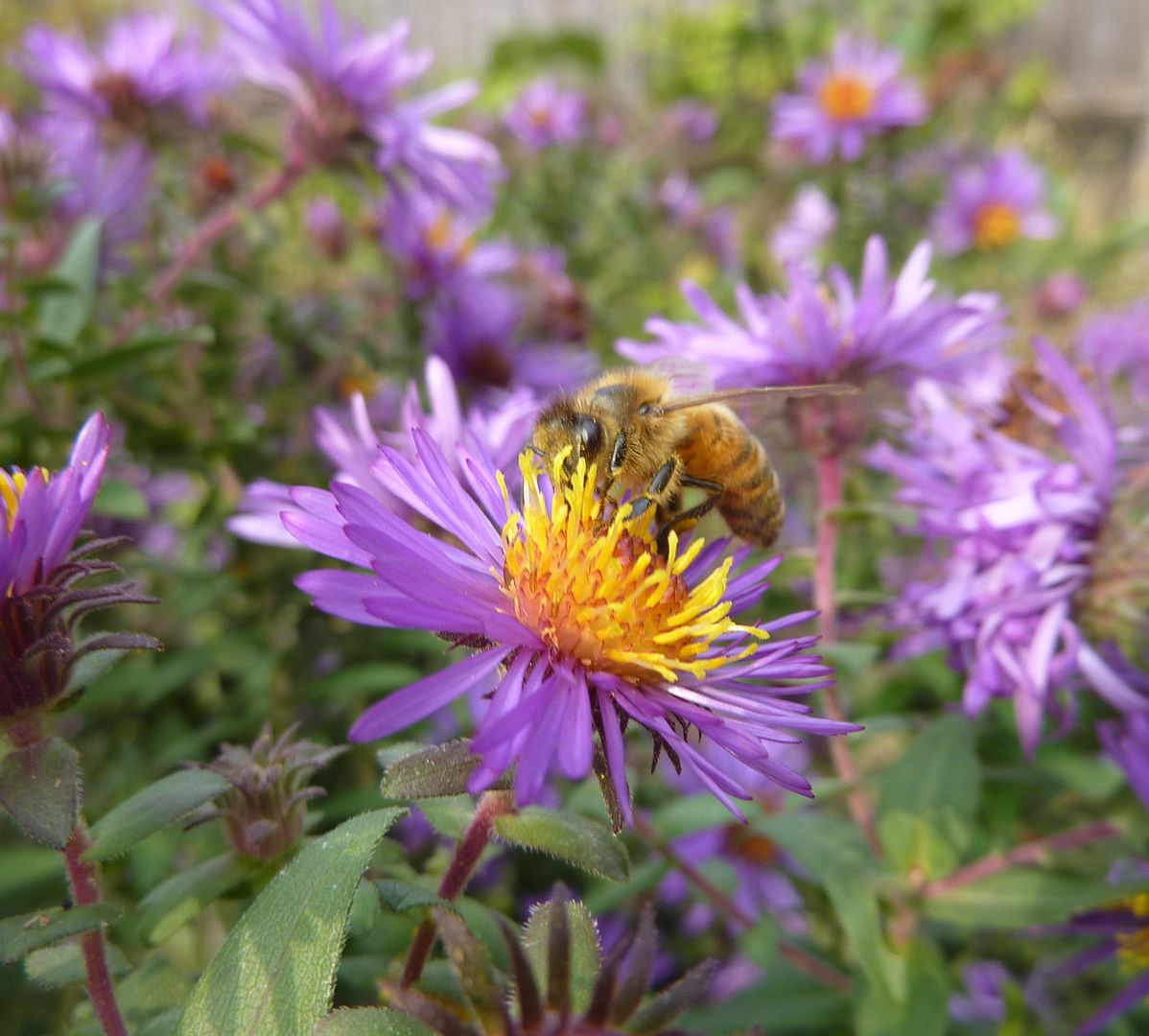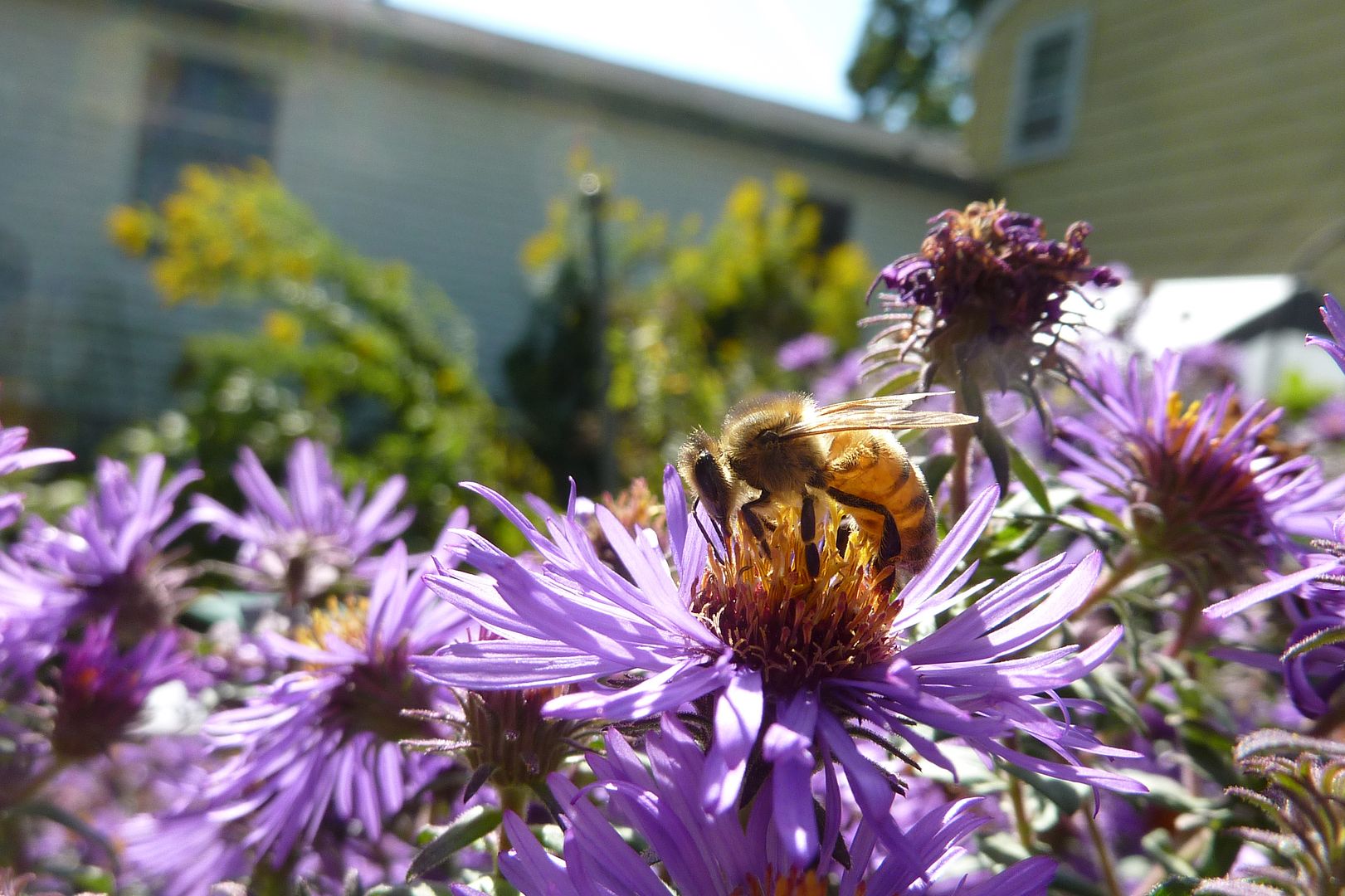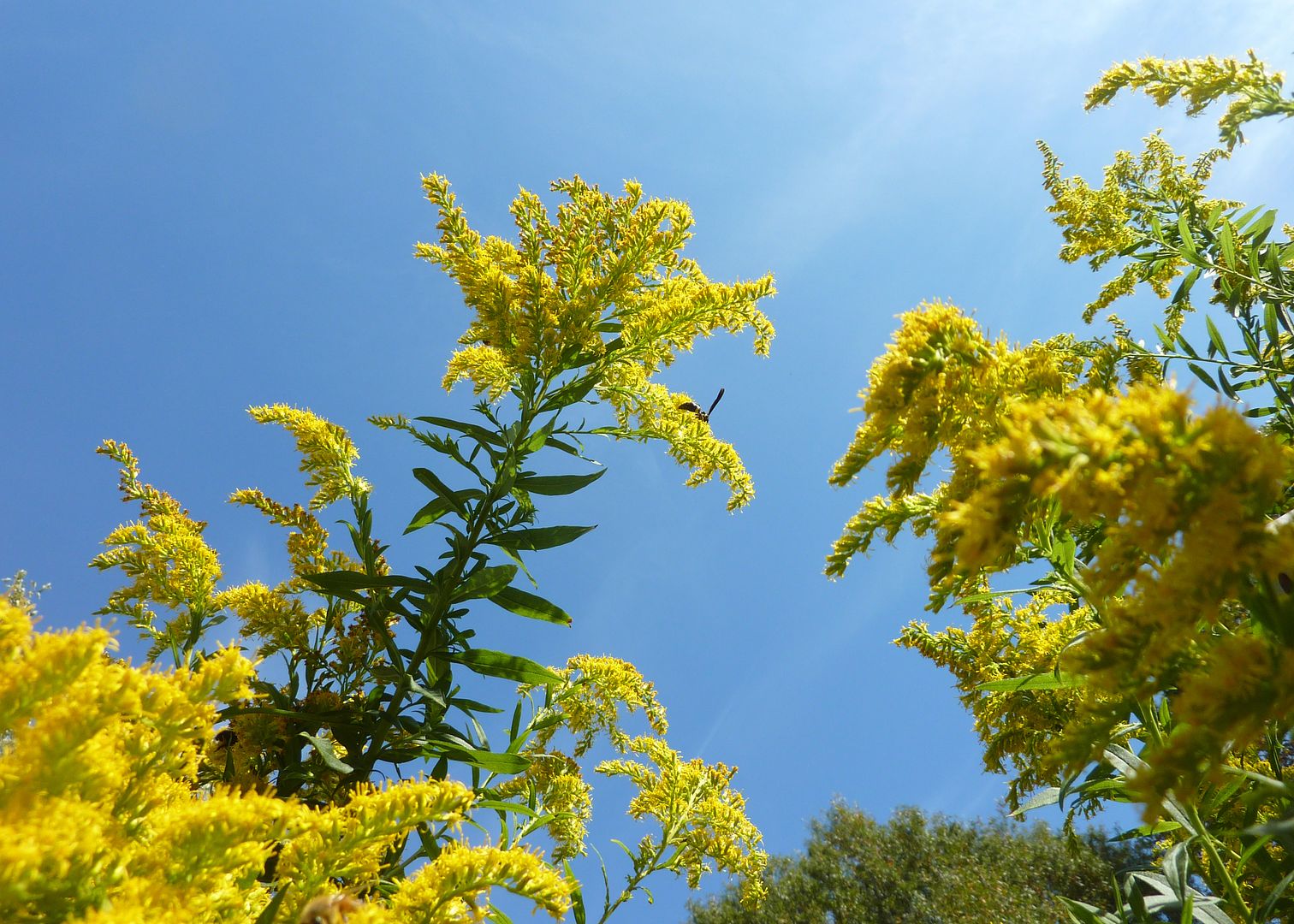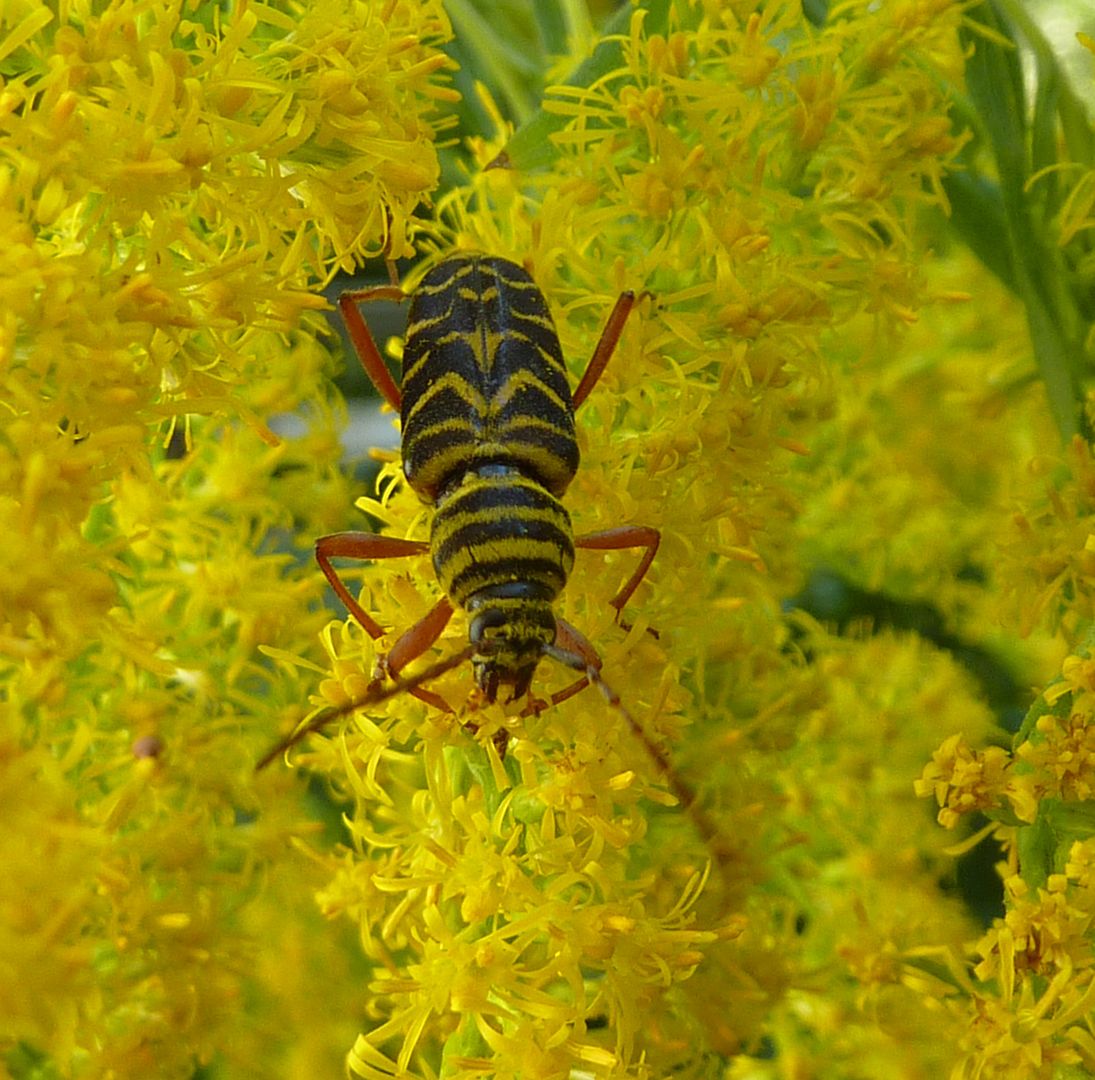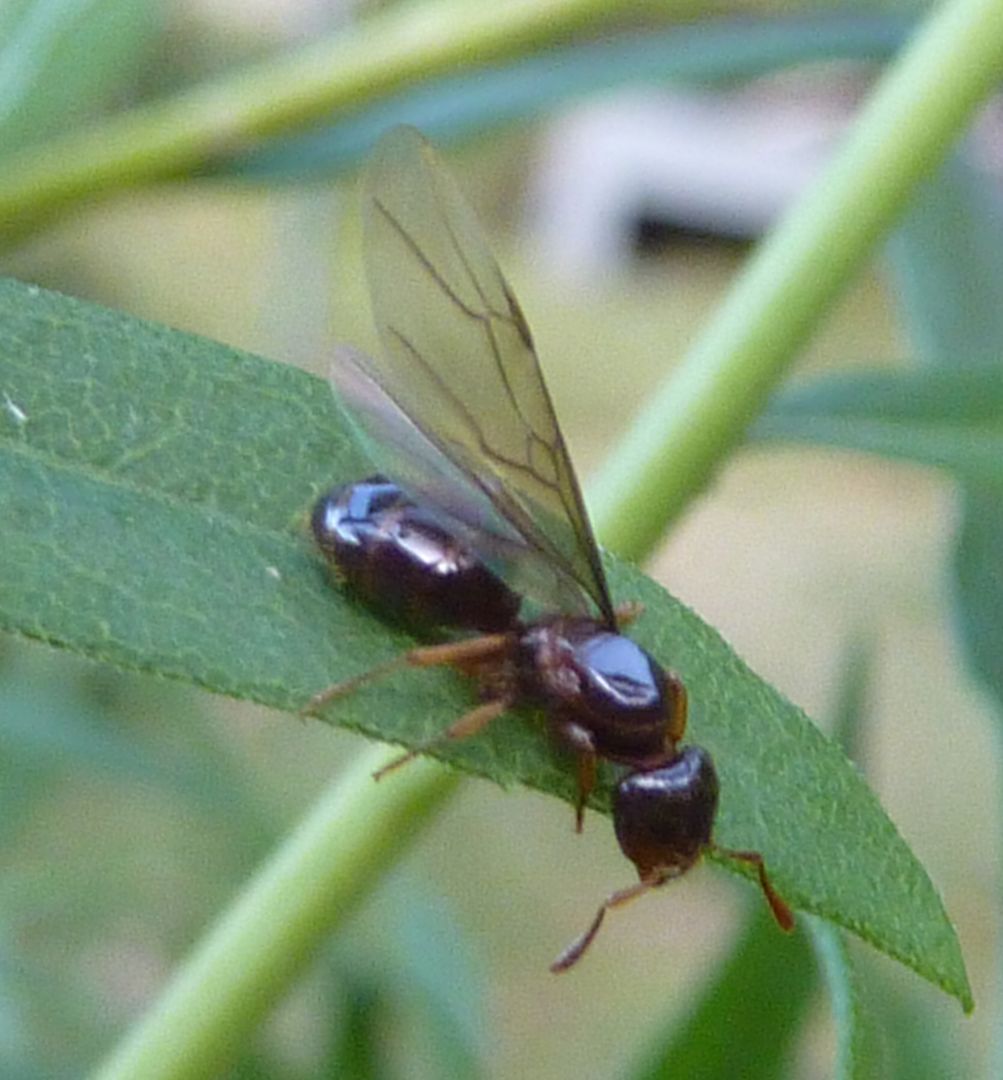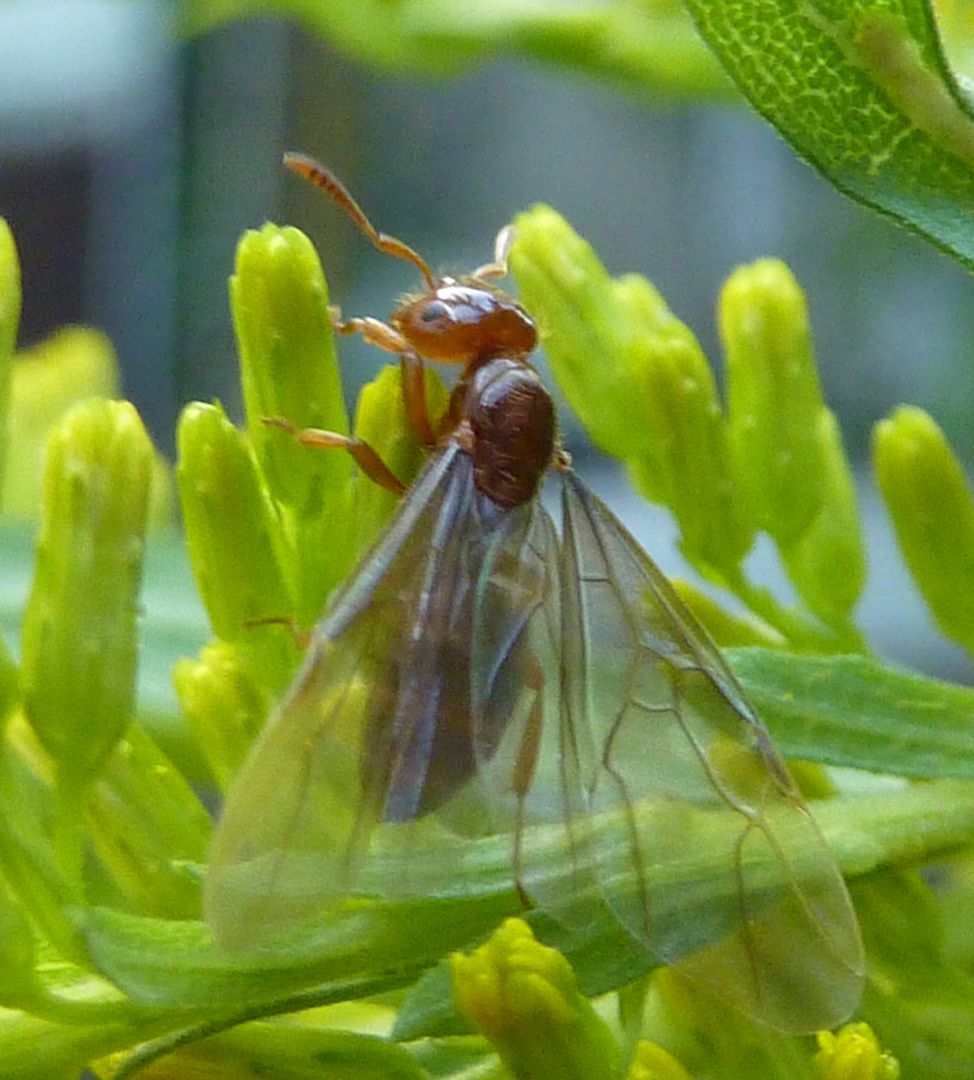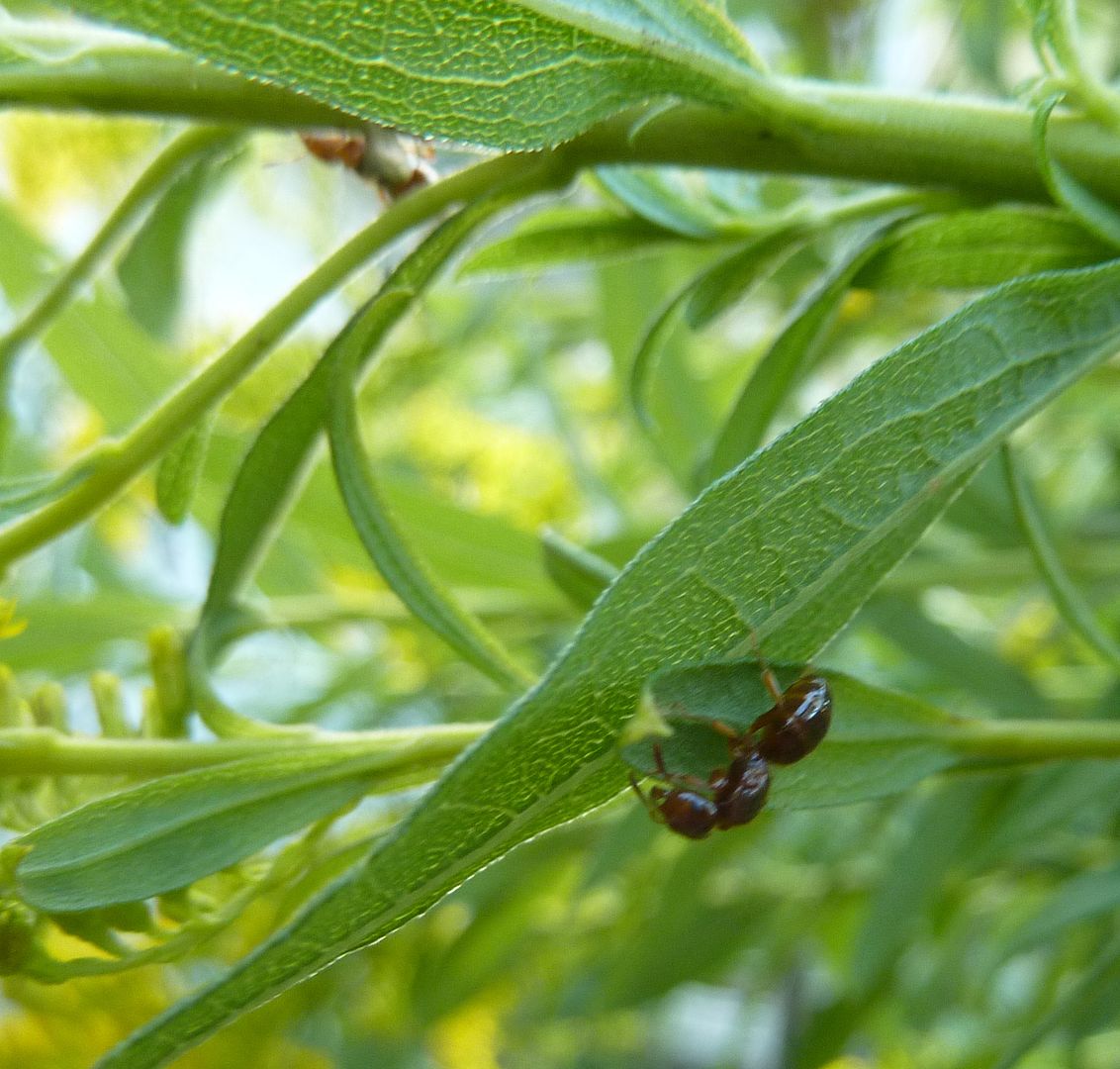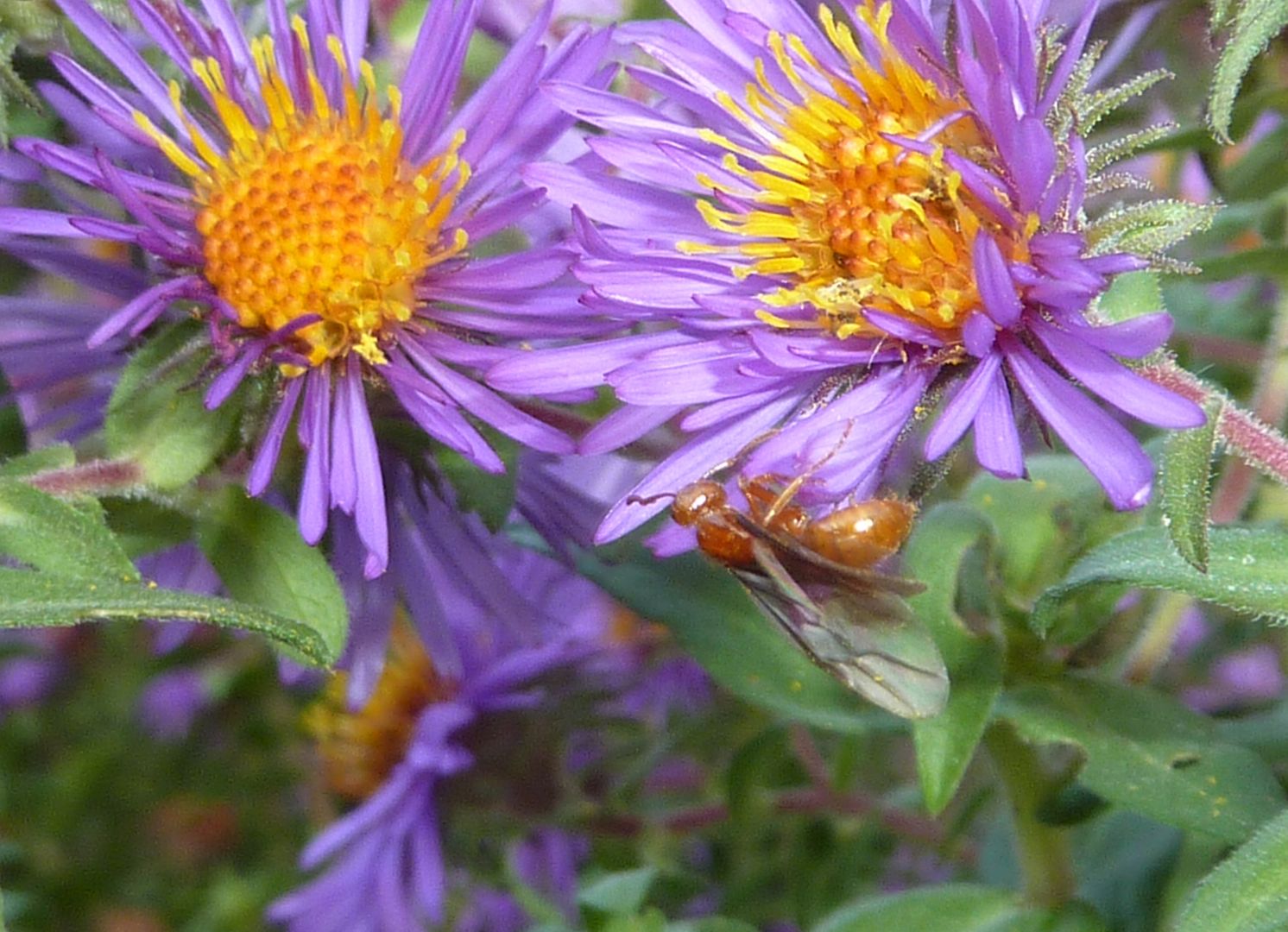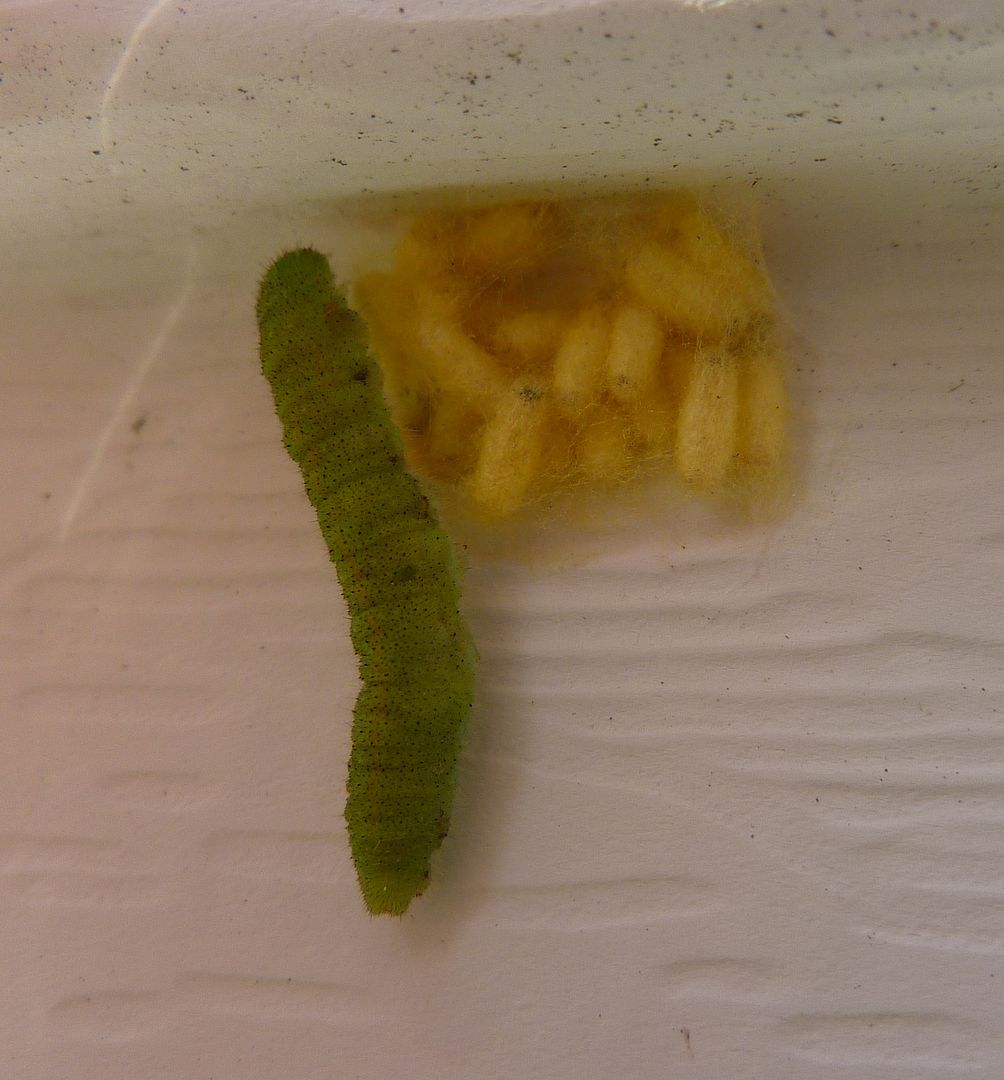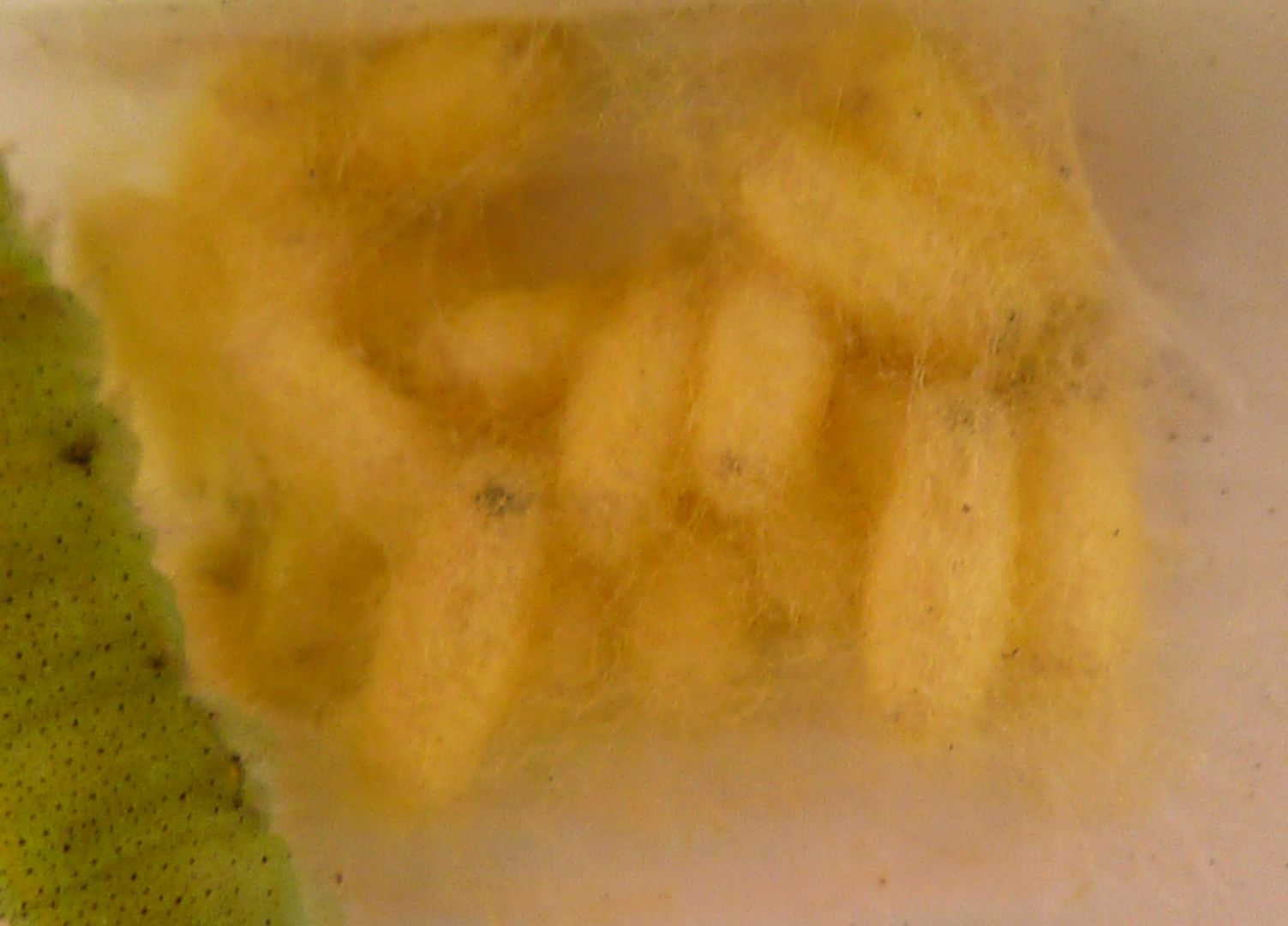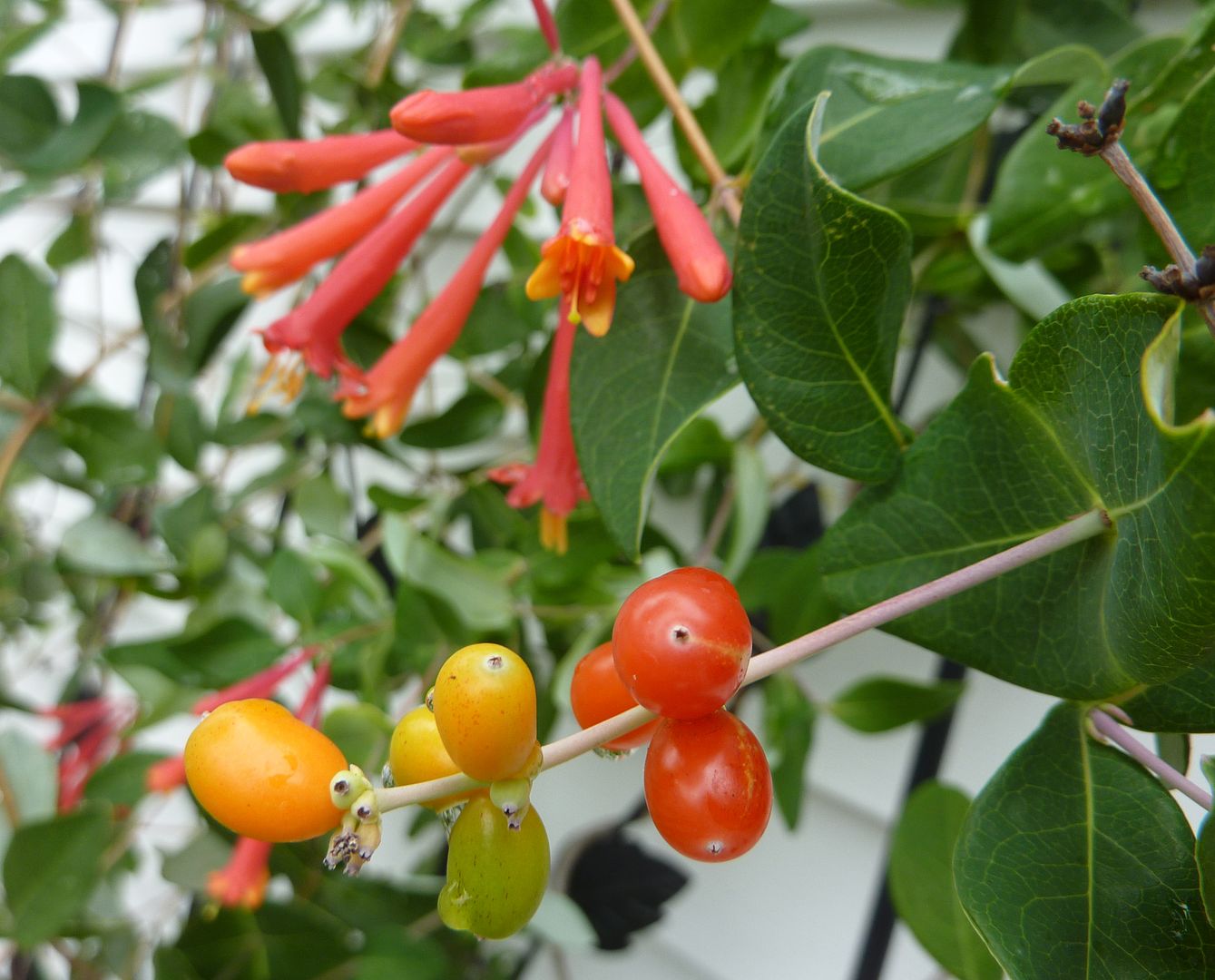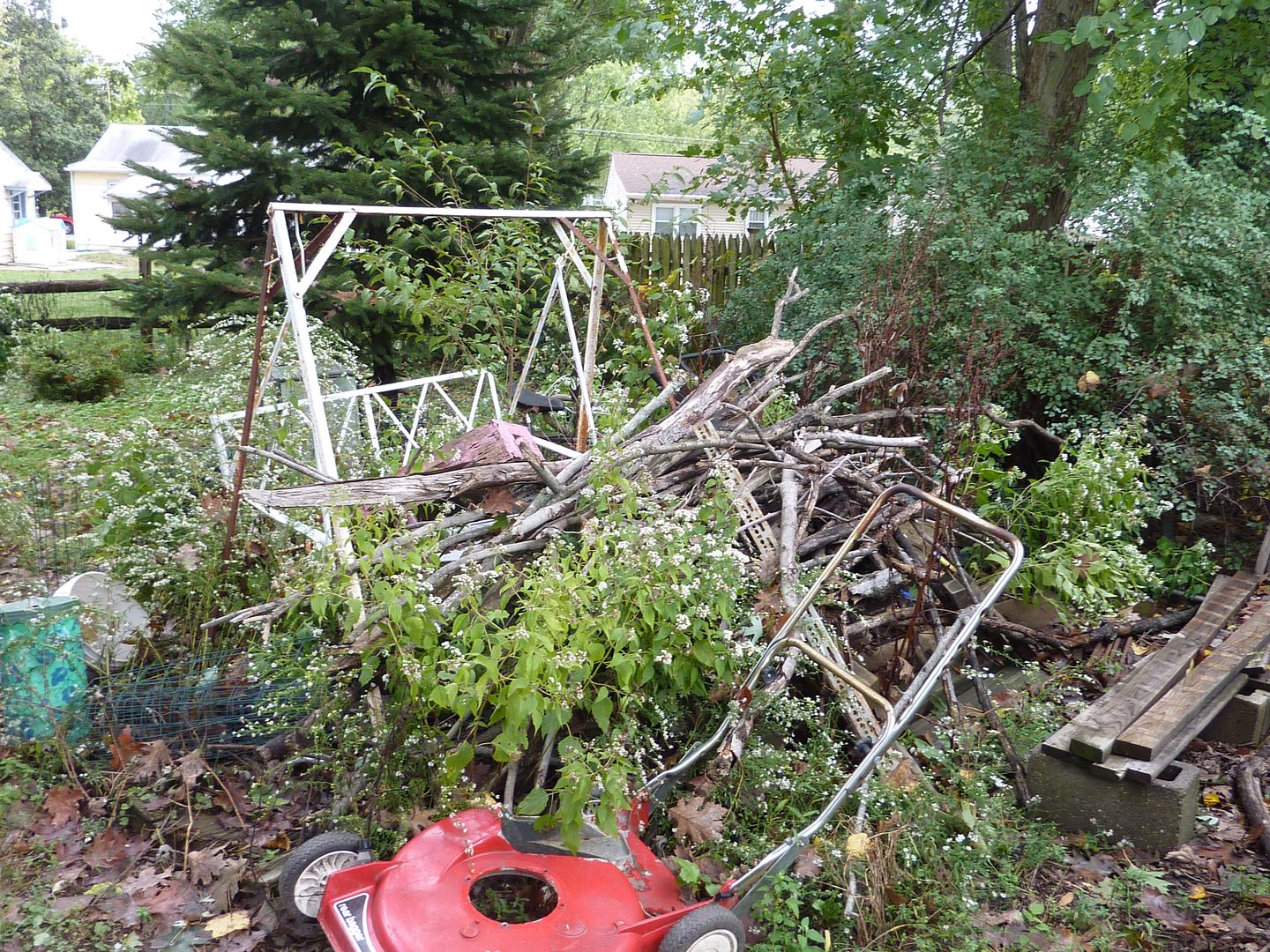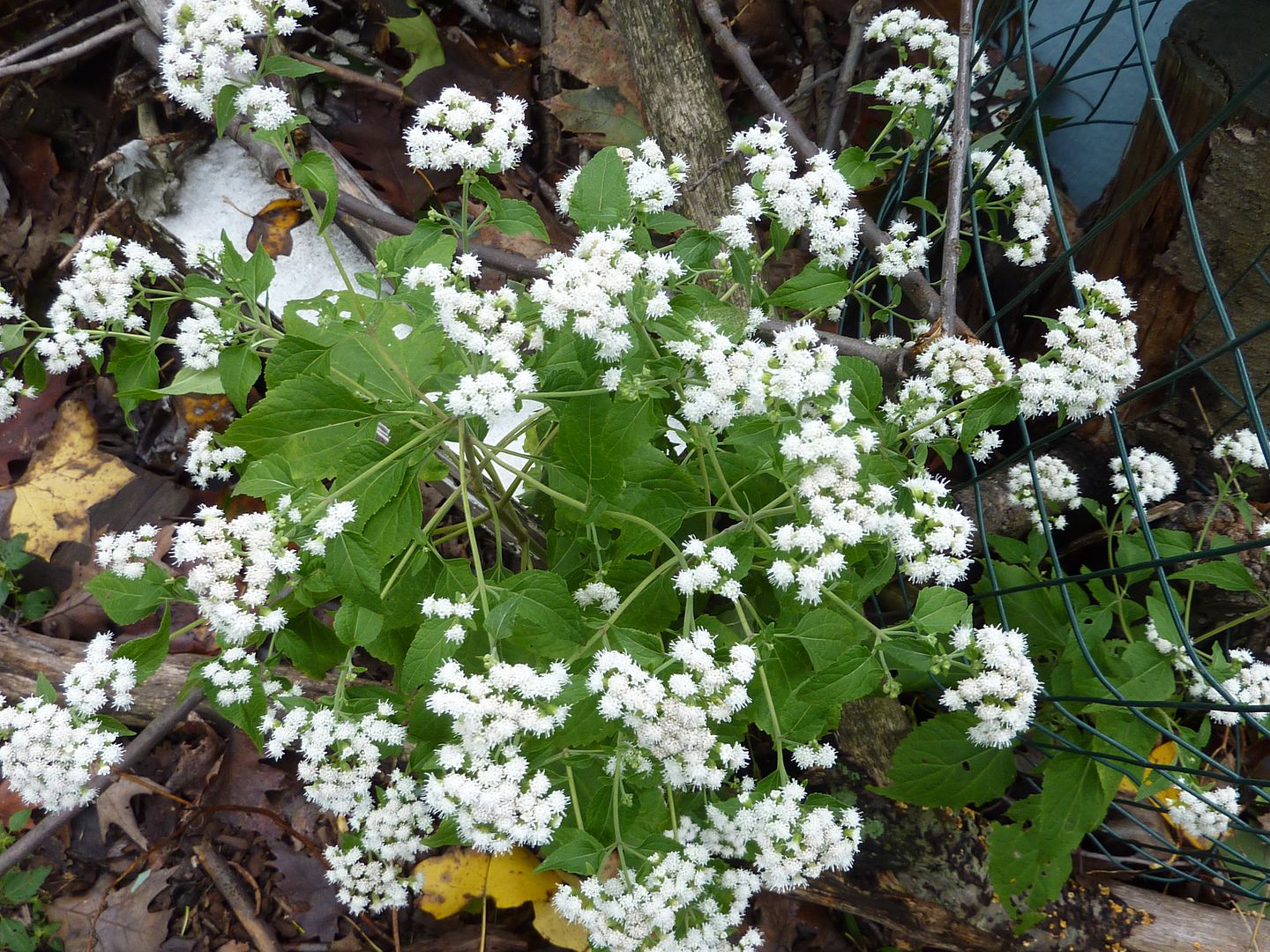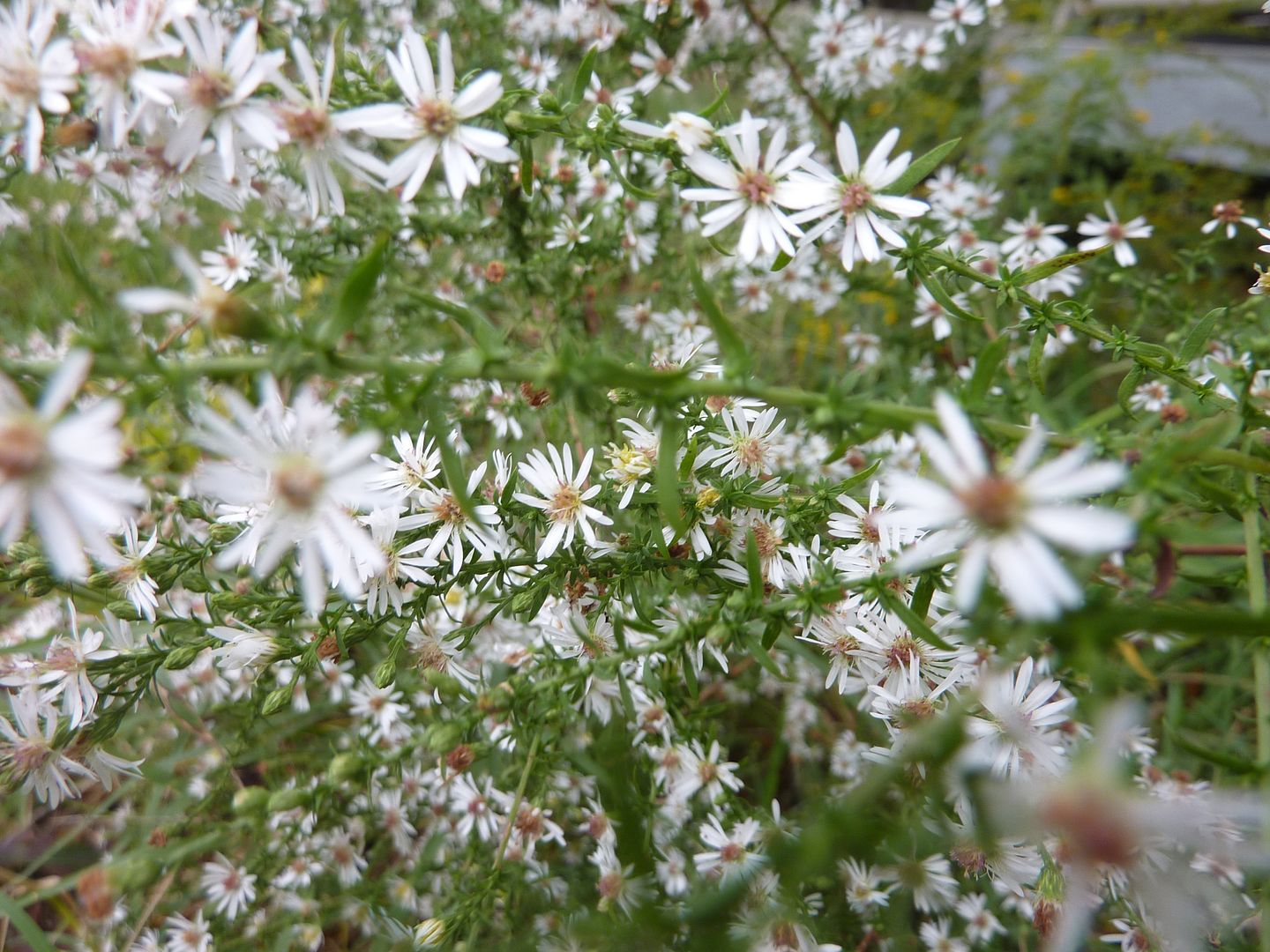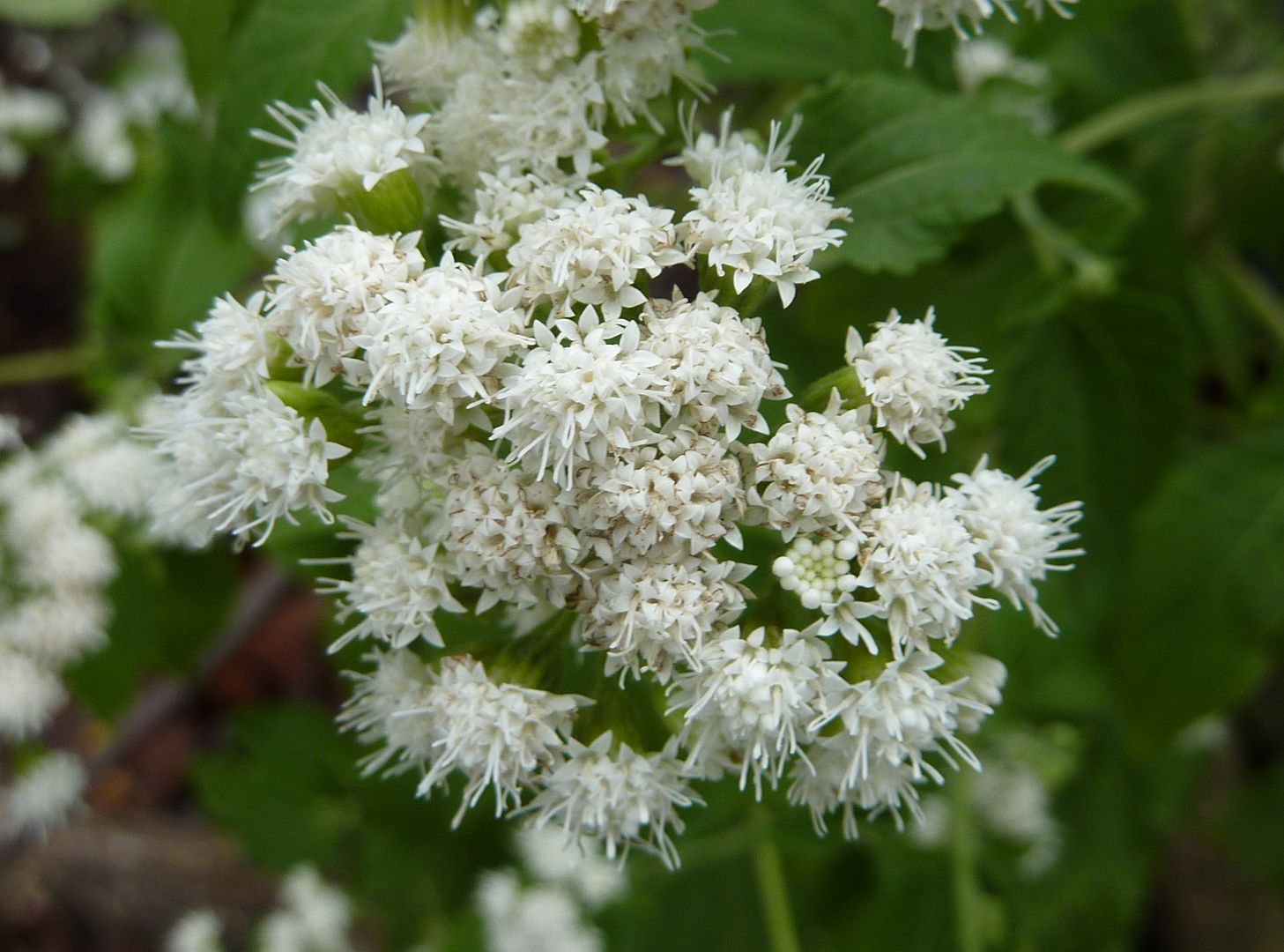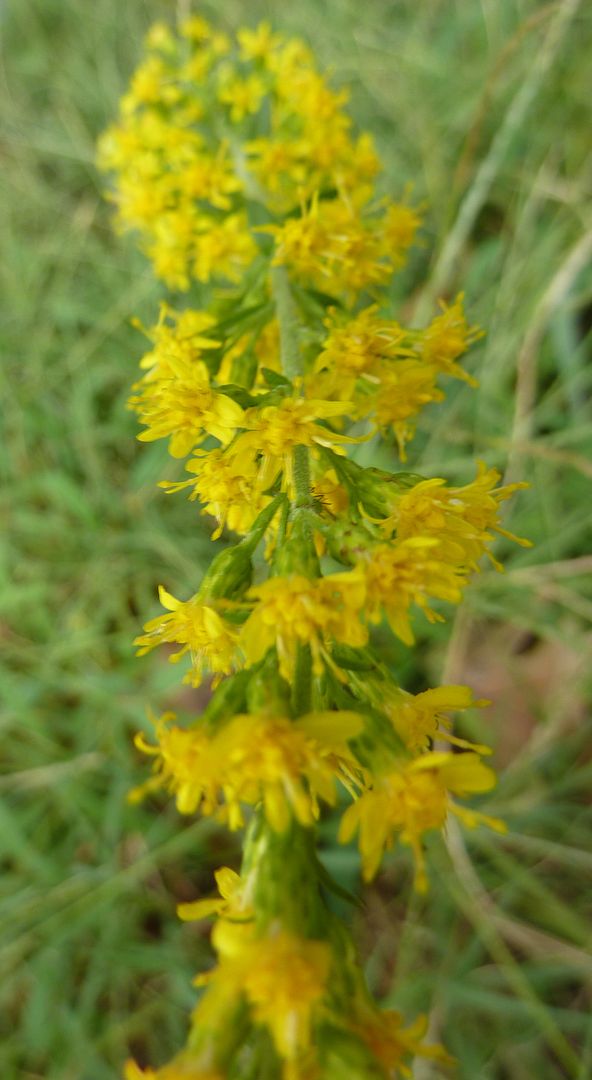Some unexpected fall color has sprung up in the garden. This is the really common Liatris you can buy corms of by the bag at generally any garden center that sells bulbs.
When fall color applies to forbs normally it's about the flowers, such as with Asters, and Goldenrod. Foliage isn't talked about much with forbs. They should really put this sort of info on the bag they come in.
Friday, October 29, 2010
Thursday, October 28, 2010
Aphids, Grass, and Ants
While cleaning up the yard some I discovered this patch of aphids under a blade of grass. There was a steady line of Prenolepis imparis, Winter Ants, visiting them. As temperatures drop down this will become one of the few species of ant out and about.
This is the first time I've seen aphids on grass.
They have a neat blue-green color to them.
This is the first time I've seen aphids on grass.
They have a neat blue-green color to them.
Labels:
Ants,
Aphids,
Grass,
Prenolepis imparis
Monday, October 25, 2010
Gluing Stuff to Bees
If we, non-scientists, can fly an iPod into space, why can't we glue antennas to some bees? I'm gonna get right on that this spring. I hope to start this as a repeating segment called Gluing Stuff to Nature.
Labels:
Bees,
Bumblebees,
Video
Friday, October 22, 2010
Talking About the Image
I think this pictures is going to be my next painting. The honeybee is just a hair out of focus for the size it's currently being viewed, but it's otherwise a strong piece I think. The lighting is even, there's a clear focus in the middle, and there's a depth of field from the flowers in the background.
This image doesn't have much of that. The harsh lighting almost turns the bee into a silhouette, there is a depth of field but it's introducing contrasting elements (Yellow and Purple are Complementary Colors), and there's a lack of middle ground which farther separates the image.
This image doesn't have much of that. The harsh lighting almost turns the bee into a silhouette, there is a depth of field but it's introducing contrasting elements (Yellow and Purple are Complementary Colors), and there's a lack of middle ground which farther separates the image.
Labels:
Aster,
Honey Bees,
Painting
Monday, October 18, 2010
Tall Goldenrod Pollinators
So this is the Goldenrod monster that lives in my backyard. Solidago altissima, Tall Goldenrod is identified as growing 5' tall, though this plant is a noted exception at 10' tall.
The leaves are narrow, long, and few if any teeth on them, and when present they're not long or clearly noticeable. They're more like small points than teeth. (presence of a mantis egg is optional.)
For those gardeners who love having really tall perennials this is a must have. My only complain is this year the storms were harsh enough that it fell over. Thankfully though this plant flowers late enough in the year that it doesn't matter to much. Considering most other perennials are dying back for fall, somehow a 10' tall plant shading them out isn't so bad.
Although this year I've resorted to using two ladders to prop these plants up, on other years they stand tall and flower beautifully. A diversity of insects use this plant as one last taste of pollen and nectar before winter sets in.
Megacyllne robiniae, The Locust Borer. Goldenrod is a common food source for this beetle. Though considered a pest it's a native species that feeds on a native tree, Robinia pseudoacacia, Black Locust Trees. It makes sense that they're around here as all the beekeepers look forward to the Locust bloom as a major boost in honey flow. The larva feed on the tree wood itself boring tunnels through the trunk. This makes them susceptible to wind storms and breaking and that can lead to disease setting in and shortening the life of the tree. Thankfully there's also the Honey Locust Tree, Gleditsia triacanthos, which is not effected by this beetle.
Buzzing around is what's likely one of next years Bumblebee queens. I think the species is Bombus impatiens.
Here they get one last taste of nectar before having to hibernate over the winter and trying to found a new hive next spring.
The leaves are narrow, long, and few if any teeth on them, and when present they're not long or clearly noticeable. They're more like small points than teeth. (presence of a mantis egg is optional.)
For those gardeners who love having really tall perennials this is a must have. My only complain is this year the storms were harsh enough that it fell over. Thankfully though this plant flowers late enough in the year that it doesn't matter to much. Considering most other perennials are dying back for fall, somehow a 10' tall plant shading them out isn't so bad.
Although this year I've resorted to using two ladders to prop these plants up, on other years they stand tall and flower beautifully. A diversity of insects use this plant as one last taste of pollen and nectar before winter sets in.
Megacyllne robiniae, The Locust Borer. Goldenrod is a common food source for this beetle. Though considered a pest it's a native species that feeds on a native tree, Robinia pseudoacacia, Black Locust Trees. It makes sense that they're around here as all the beekeepers look forward to the Locust bloom as a major boost in honey flow. The larva feed on the tree wood itself boring tunnels through the trunk. This makes them susceptible to wind storms and breaking and that can lead to disease setting in and shortening the life of the tree. Thankfully there's also the Honey Locust Tree, Gleditsia triacanthos, which is not effected by this beetle.
Buzzing around is what's likely one of next years Bumblebee queens. I think the species is Bombus impatiens.
Here they get one last taste of nectar before having to hibernate over the winter and trying to found a new hive next spring.
Sunday, October 17, 2010
Tall Goldenrod, Solidago altissima
This is what I believe to be Solidago altissima, Tall Goldenrod. However, I actually wasn't able to find any source mentioning any goldenrod growing to be more than 8' tall and the tallest cane here was over 10'. I must have some good poorly drained, compacted clay soil or something.
Here is what I believe is a queen bumblebee storing up food for next spring. There were a few buzzing about on the plant. Bumblebees shouldn't be confused with the Giant Resin Bee, or Giant Carpenter Bees.
Friday, October 15, 2010
Ants on the Aster Family
It's fall time and the last of the ant nuptial flights have been underway for a few weeks now. It's only appropriate that this happens with the last of the blooms too.
Lasius claviger and Lasius umbratus queens emerge from nests during the afternoon hours.
For some reason I find lots of them hanging out in goldenrod plants that are still in bloom, but only during the hours of the nuptial flight itself. Come darkness they disband and take to the ground looking for a host colonies.
I'm not sure what it is about goldenrod that attracts them so. This isn't the result of a colony under the plant and the queens simply trying to climb up high to take off. Many of the queens are stationary on the plant and have shed their wings.
The only thing I can come up with is they're attracted to the light scent the flowers give off. In case you're wondering this plant is Solidago gigantea. It's one of the tallest goldenrods in North America. Online sources say it gets up to 8' but I've seen it surpass 10' on some years.
So this got me thinking, maybe they're not attracted to just Goldenrods but perhaps other plants in the composite family.
Sure enough upon inspecting my New England Aster I found a queen or two on the plant. However, I was only able to find two total.
And these were trying to take off. They were not being relatively stationary on the plant. So it's looking like they're only attracted to Goldenrods that are in bloom. I checked other plants as well and couldn't find them on anything else.
Lasius claviger and Lasius umbratus queens emerge from nests during the afternoon hours.
For some reason I find lots of them hanging out in goldenrod plants that are still in bloom, but only during the hours of the nuptial flight itself. Come darkness they disband and take to the ground looking for a host colonies.
I'm not sure what it is about goldenrod that attracts them so. This isn't the result of a colony under the plant and the queens simply trying to climb up high to take off. Many of the queens are stationary on the plant and have shed their wings.
The only thing I can come up with is they're attracted to the light scent the flowers give off. In case you're wondering this plant is Solidago gigantea. It's one of the tallest goldenrods in North America. Online sources say it gets up to 8' but I've seen it surpass 10' on some years.
So this got me thinking, maybe they're not attracted to just Goldenrods but perhaps other plants in the composite family.
Sure enough upon inspecting my New England Aster I found a queen or two on the plant. However, I was only able to find two total.
And these were trying to take off. They were not being relatively stationary on the plant. So it's looking like they're only attracted to Goldenrods that are in bloom. I checked other plants as well and couldn't find them on anything else.
Wednesday, October 13, 2010
Garden Girl TV and Paw Paws
This is one of the better videos about Paw Paw fruit I've seen. You actually get a sense and feel for the fruit though seeing her cutting a few open to make a smoothie. Hopefully more people will start planting Paw Paws now. (Note they take two varieties to pollinate, and are pollinated by flies and carrion beetles, as opposed to bees.)
CCD is Not Caused by Pesticides
Why don't studies like This make the news?
This little sentance is all I would have needed to read. You see, I've been a firm believer that CCD was simply a pesticide issue for years now and no one was caring because it was likely happening on crops that don't use honey bee pollination, however the bees were still using the crop for food or water anyhow. When you have a pesticide like neonicotinoides out on the market that stay active for 9 months inside the plant, that sounds strong enough to wipe out a few hives to me.
So what that one sentance means is, insecticides are a separate problem and CCD has some other elusive cause. Those genes should have been active if pesticides were present. Seriously, you'd think a company like Bayer would be propagandizing the hell out of that study! Do they like being the bad guys?
Going back to the study linking viruses and fungi to CCD I still have trouble understanding the findings in that lower chart. And my concerns still stand. Without knowing more it really does seem like something got to their samples and the virus fungi invasion is a result. Maybe they weren't feeding their samples and thats why so many of their control bees died? How great would it be if online studies included videos detailing their work? I need to start YouTube for scientific studies or something.
I would like to thank Alex Wild for setting the me straight. His blog at Myrmecos.net is where I found the study explaining the pesticide thing.
"Overall, elevated expression of pesticide response genes was not observed."
This little sentance is all I would have needed to read. You see, I've been a firm believer that CCD was simply a pesticide issue for years now and no one was caring because it was likely happening on crops that don't use honey bee pollination, however the bees were still using the crop for food or water anyhow. When you have a pesticide like neonicotinoides out on the market that stay active for 9 months inside the plant, that sounds strong enough to wipe out a few hives to me.
So what that one sentance means is, insecticides are a separate problem and CCD has some other elusive cause. Those genes should have been active if pesticides were present. Seriously, you'd think a company like Bayer would be propagandizing the hell out of that study! Do they like being the bad guys?
Going back to the study linking viruses and fungi to CCD I still have trouble understanding the findings in that lower chart. And my concerns still stand. Without knowing more it really does seem like something got to their samples and the virus fungi invasion is a result. Maybe they weren't feeding their samples and thats why so many of their control bees died? How great would it be if online studies included videos detailing their work? I need to start YouTube for scientific studies or something.
I would like to thank Alex Wild for setting the me straight. His blog at Myrmecos.net is where I found the study explaining the pesticide thing.
Labels:
beekeeping,
Bees,
Study
Monday, October 11, 2010
And Another Thing! (CCD New York Times Article)
And another thing! Why did 40% of their control die after 14 days. Each group was comprised of young worker bees 3 days old or younger (they can't fly at that age and are easy to handle). Honey bee workers normally live 30 to 60 days. Why did 40% of their control die after 14 days! Why is the difference between having one infestation over both at the same time only 10% after a 14 day period.
The article claims a hive can survive if they only have one of either the fungi or the virus. Their control should have had a survival rate above or around 90%, the virus and fungi separately should have been higher as well. It's hard to bounce back when more than half of the hive dies off after 14 days, worker bees aren't even foraging until day 12. What we're seeing here is clearly all of the groups have been contaminated with what ever causes CCD and the presence of the virus and or fungi just make it worse.
A friend sent this article to me earlier today.
What a Scientist Didn't Tell the New York Times About His Study on Bee Deaths
...The Times reporter who authored the recent article, Kirk Johnson, responded in an e-mail that Dr. Bromenshenk "did not volunteer his funding sources." Johnson's e-mail notes that he found the peer-reviewed scientific paper cautious and that he "tried to convey that caution in my story." Adds Johnson: The study "doesn't say pesticides aren't a cause of the underlying vulnerability that the virus-fungus combo then exploits...."
Underlying cause of bee deaths still unclear
Dr. Jennifer Sass, a senior scientist with the health group at the Natural Resources Defense Council, says that while the Bromenshenk/Army study is interesting, it fails to ask the underlying question "Why are colonies dying? Is it because they're getting weak? People who have HIV don't die of HIV. They die of other diseases they get because their immune systems are knocked off, making them more susceptible." In other words, pesticides could weaken the bees -- and then the virus/fungus combination finishes them off. That notion, however, is not explored in the new study.
...
The EPA has based its approval of neonicotinoids on the fact that the amounts found in pollen and nectar were low enough to not be lethal to the bees -- the only metric they have to measure whether to approve a pesticide or not. But studies have shown that at low doses, the neonicotinoids have sublethal effects that impair bees' learning and memory. The USDA's chief researcher, Jeff Pettis, told me in 2008 that pesticides were definitely "on the list" as a primary stressor that could make bees more vulnerable to other factors, like pests and bacteria.
Labels:
beekeeping,
CCD,
Study
Saturday, October 9, 2010
My Thoughts on Virues and Fungi cause CCD
Iridovirus and Microsporidian Linked to Honey Bee Colony Decline
Alright so it's been a few days since this came out. I have been reading it and have come to the conclusion that it's nothing too special. In short they took samples of bees from 2006 to 2009 (2010?) from CCD effected hives, and they've listed all the correlating combinations of viruses and fungi that seem to cause CCD.
I'd be interested to know what the bees were pollinating? How were they coming into contact with these viruses and fungi spores? But unfortunately we probably don't know that much about the ones killing the bees in this case.
I can see a definite drop here... but what is the correlation again? This chart seems to show that the Virus and the Nosema don't have to be together to cause CCD. It looks like they can kill bees well enough on their own.
Alright so it's been a few days since this came out. I have been reading it and have come to the conclusion that it's nothing too special. In short they took samples of bees from 2006 to 2009 (2010?) from CCD effected hives, and they've listed all the correlating combinations of viruses and fungi that seem to cause CCD.
I'd be interested to know what the bees were pollinating? How were they coming into contact with these viruses and fungi spores? But unfortunately we probably don't know that much about the ones killing the bees in this case.
We also observed Varroa mites in some, but not all of the CCD colonies.Excuse me? You didn't find mites in all of the beehives? Okay either you're not looking hard enough or those hives recently re-queened or something. There are Varroa mites in every beehive! Drones which move freely from hive to hive (just droning on with their lives of one day mating or not) are just one way that Varroa mites enter the hive. Enlarged drone cells are often targeted by the mites too.
These results support the correlation observed by the MSP data that suggests than an interaction between N. ceranae and an IIV-6-like virus may be involved in bee mortality.Why isn't the bees immune system fighting back?
I can see a definite drop here... but what is the correlation again? This chart seems to show that the Virus and the Nosema don't have to be together to cause CCD. It looks like they can kill bees well enough on their own.
Labels:
beekeeping,
CCD,
Study
Common Buckeye Sightng
Junonia coenia, Common Buckeye. This little jewel scurried out of the brush outback (I haven't been mowing the lawn,) and I can't help but think what a shame it is that adults and caterpillars don't over winter where I am. Even though I have an abundance of one of their host plants growing like a weed outback, Plantain. No not the banana; Plantago major, the small little plant who's sap is supposidly good for bee stings and bug bites. Other hosts include common everyday snapdragons, something called toadflax, Gerardia, as well as Ruellia nodiflora. This info is brought to you by...
Labels:
Book,
Butterflies,
Lepidoptera
Friday, October 8, 2010
Caterpillars Eaten from the Inside Out
Labels:
Caterpillar,
Parasitic,
Wasp
Busy Bees on New England Aster
Well the New England Aster, Symphyotrichum novae-angliae, has started blooming up a storm. This plant comes in other colors as well including red, pink, purple and pale or intense versions of those. What's great though is you always get the intense yellow anthers inside the flower that play off the color so nicely, even against spent flower heads that are brown and going to seed. The only down side as you can see in the video is the plants can get to tall and fall over. This is usually avoided at the nursery because the plants will have been cut back to a few inches in June or July. This promotes the compact flowering part to form closer to the ground.
 |
| A Honey Bee working a New England Aster |
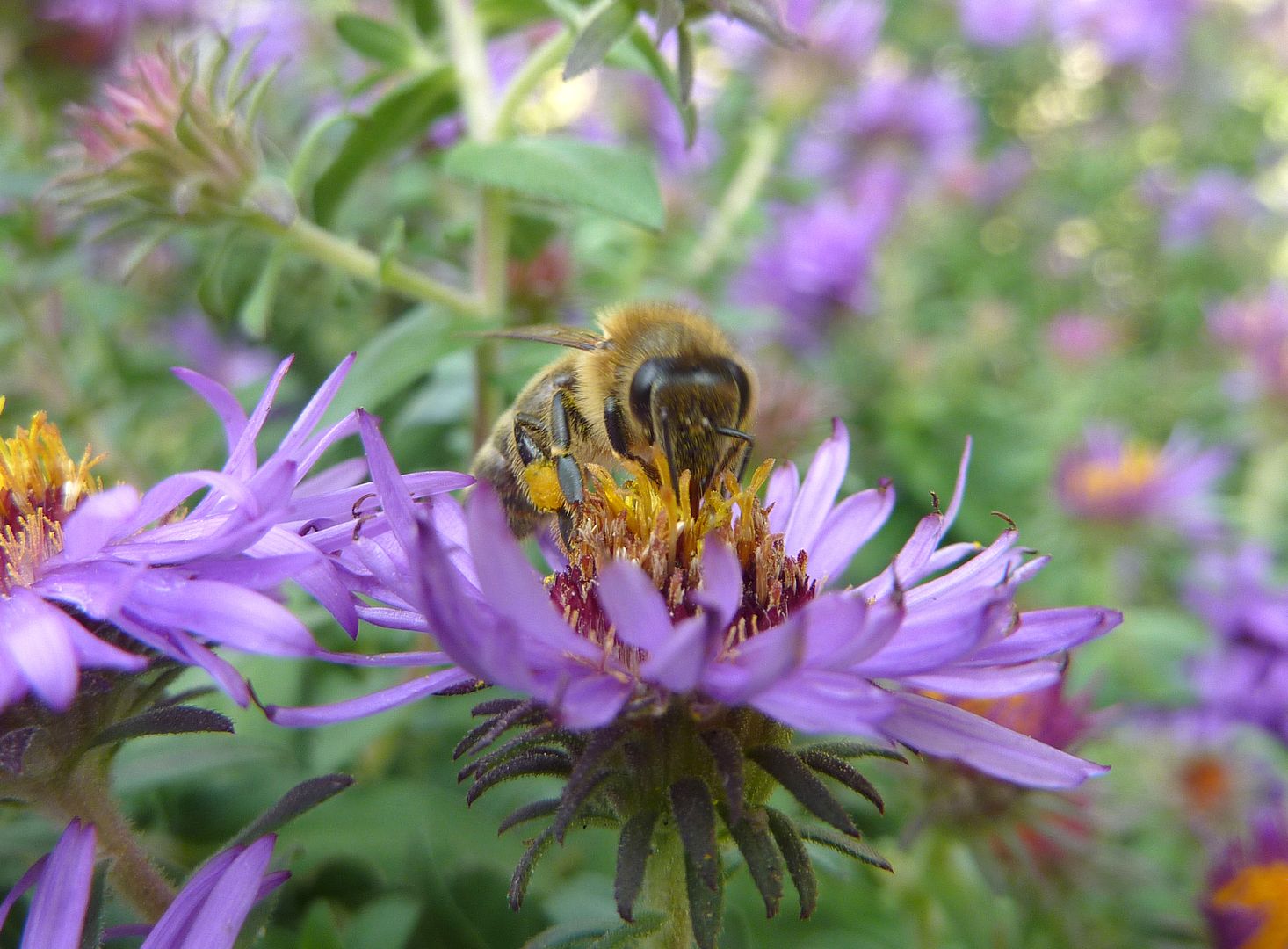 |
| A Honey Bee working a New England Aster |
 |
| A Honey Bee working a New England Aster |
 |
| A Green Sweat Bee working a New England Aster |
Labels:
Aster,
Bees,
Color,
fall color,
flowers,
Honey Bees,
Plants,
Video
Thursday, October 7, 2010
Viruses and Fungi Combination Linked to CCD
Jerry Bromenshenk is my new hero for the moment. A New York Times article today talked about the findings that a new study has found a link between a virus and fungi combination that is causing CCD. The article also mentions his using of honey bees to help detect land mines. Which shockingly enough has evidence to back it up. Read here! Detecting explosives with honey bees aside, here is the abstract to the scientific study linking viruses and fungi to CCD that the article is based on.
So basically the viruses got on their cell phones and called the fungi, and were all like, "Yo, I'm inside a Bee! Why don't you come join me?" And the scientists (the stupid ones anyhow) were all like ... Cell Phones cause CCD!
Granted I had my own little theory, or at least I sided with the people saying it was neonicotinoid sprayed crops that sweat out the chemical in their sap. That has proven incorrect but at least it was more plausible a theory than putting a cell phone in a bee hive and calling them up.
---------------------------------------------------------------------------------------------------
Iridovirus and Microsporidian Linked to Honey Bee Colony Decline
Abstract
Background
In 2010 Colony Collapse Disorder (CCD), again devastated honey bee colonies in the USA, indicating that the problem is neither diminishing nor has it been resolved. Many CCD investigations, using sensitive genome-based methods, have found small RNA bee viruses and the microsporidia, Nosema apis and N. ceranae in healthy and collapsing colonies alike with no single pathogen firmly linked to honey bee losses.
Methodology/Principal Findings
We used Mass spectrometry-based proteomics (MSP) to identify and quantify thousands of proteins from healthy and collapsing bee colonies. MSP revealed two unreported RNA viruses in North American honey bees, Varroa destructor-1 virus and Kakugo virus, and identified an invertebrate iridescent virus (IIV) (Iridoviridae) associated with CCD colonies. Prevalence of IIV significantly discriminated among strong, failing, and collapsed colonies. In addition, bees in failing colonies contained not only IIV, but also Nosema. Co-occurrence of these microbes consistently marked CCD in (1) bees from commercial apiaries sampled across the U.S. in 2006–2007, (2) bees sequentially sampled as the disorder progressed in an observation hive colony in 2008, and (3) bees from a recurrence of CCD in Florida in 2009. The pathogen pairing was not observed in samples from colonies with no history of CCD, namely bees from Australia and a large, non-migratory beekeeping business in Montana. Laboratory cage trials with a strain of IIV type 6 and Nosema ceranae confirmed that co-infection with these two pathogens was more lethal to bees than either pathogen alone.
Conclusions/Significance
These findings implicate co-infection by IIV and Nosema with honey bee colony decline, giving credence to older research pointing to IIV, interacting with Nosema and mites, as probable cause of bee losses in the USA, Europe, and Asia. We next need to characterize the IIV and Nosema that we detected and develop management practices to reduce honey bee losses.
So basically the viruses got on their cell phones and called the fungi, and were all like, "Yo, I'm inside a Bee! Why don't you come join me?" And the scientists (the stupid ones anyhow) were all like ... Cell Phones cause CCD!
Granted I had my own little theory, or at least I sided with the people saying it was neonicotinoid sprayed crops that sweat out the chemical in their sap. That has proven incorrect but at least it was more plausible a theory than putting a cell phone in a bee hive and calling them up.
Iridovirus and Microsporidian Linked to Honey Bee Colony Decline
Labels:
beekeeping,
CCD,
Study
Saturday, October 2, 2010
Still Flowering
While some gardeners have been searching high and low for fall color this native honeysuckle, Lonicera sempervirens has been flowering since early spring! They bloom early for the hummingbird migration. Afterward, flowering dies down but continues sporadically over the summer. Now that it's getting cold again they're putting on another dazzling show for the migration back.
A delightful treat for other birds slowly form on the vine. I can't imagen hummingbirds eating the berries. Hopefully I'll get to photograph what does.
A delightful treat for other birds slowly form on the vine. I can't imagen hummingbirds eating the berries. Hopefully I'll get to photograph what does.
Friday, October 1, 2010
A Few Volunteers
... No this isn't a post asking for help getting this crap out of the yard. Though if someone would like to tell me the protocol for throwing away a glider from the 1980's that would be a great help. This is actually the spot we put all the miscellaneous things. The lawnmower lacking an engine is the easiest way to move a 300+ pound beehive. The rest is just a stack of branches to big or small to do much with. I'm posting this though becuase of the wildflowers naturally growing around all this. I didn't plant any of these. The species have been here for plants, they all have been growing here since before the house was built and slowly spreading about in the untamed parts of the yard. (though that may have had something to do with the lawnmower breaking.)
A White Wood Aster of some type is one.
The other is White Snakeroot. This plant is notorious for causing livestock to produce poisonous milk at least to humans. Not a plant that farmers or people with to much land should be growing, at least if there is livestock around.
Both plants are typically swarming with pollinators, usually smaller flies and sweat bees though. Rarely I'll see a honey bee on them and surprisingly enough I have never seen a bumblebee working either plant.
I took these pictures on a cloudy day where it had rained all morning. So there wasn't much out. Normally I'm not a fan of white flowering plants, and these two in particular aren't the prettiest I've seen. But there's something about them planted in mass, and if the light hits them just right that makes the whole area look prettier than it does on other times of the years.
The yard is littered with young plants with both species. If our yard became uncared for these two would surely take over among other plants.
Another plant slowly springing up all over is one of the shorter Goldenrods. Barely reaching 2' tall, I see this plant coming up in the dryer parts. This is the 5th species of Goldenrod to start growing out in the yard. I suppose this is a benefit to not weeding out the garden. But I guess the lesson here would be to learn what young plants look like before weeding it out.
The last volunteer I'll talk about is this pumpkin. The vine probably measures 25' and wasn't planted by me. Last year's compost pile was turned into a garden and this plant started growing of it's own steam. I allowed it to grow because I was curious to see what it would become. Watermelon, Cantaloupe/Muskmelon, Zucchini, and so on all look like the exact same vine to me, and some of them are simply the result of selectively breeding certain traits in and out of the plant.
A White Wood Aster of some type is one.
The other is White Snakeroot. This plant is notorious for causing livestock to produce poisonous milk at least to humans. Not a plant that farmers or people with to much land should be growing, at least if there is livestock around.
Both plants are typically swarming with pollinators, usually smaller flies and sweat bees though. Rarely I'll see a honey bee on them and surprisingly enough I have never seen a bumblebee working either plant.
I took these pictures on a cloudy day where it had rained all morning. So there wasn't much out. Normally I'm not a fan of white flowering plants, and these two in particular aren't the prettiest I've seen. But there's something about them planted in mass, and if the light hits them just right that makes the whole area look prettier than it does on other times of the years.
The yard is littered with young plants with both species. If our yard became uncared for these two would surely take over among other plants.
Another plant slowly springing up all over is one of the shorter Goldenrods. Barely reaching 2' tall, I see this plant coming up in the dryer parts. This is the 5th species of Goldenrod to start growing out in the yard. I suppose this is a benefit to not weeding out the garden. But I guess the lesson here would be to learn what young plants look like before weeding it out.
The last volunteer I'll talk about is this pumpkin. The vine probably measures 25' and wasn't planted by me. Last year's compost pile was turned into a garden and this plant started growing of it's own steam. I allowed it to grow because I was curious to see what it would become. Watermelon, Cantaloupe/Muskmelon, Zucchini, and so on all look like the exact same vine to me, and some of them are simply the result of selectively breeding certain traits in and out of the plant.
Labels:
Aster,
Goldenrod,
Plants,
White Snakeroot
Eat The Weeds: The Hollies
Another excellent video by Green Dean, this time it's about making tea from Hollies. As an avid tea drinker I thoroughly enjoyed this episode and am looking into getting a dwarf holly tree for those purposes. The nonnative my parents bought and planted isn't doing so well and the recent storm we had somehow sent a bike into what remains of the bush.
Labels:
Eat the Weeds,
Plants
Subscribe to:
Posts (Atom)

